Seung-hoon Jeong
Georges (Daniel Auteuil), a host of a high-brow talk show, receives suspicious videotapes that display the peaceful façade of his upper middle class house. Nothing is clear in this CCTV footage in which there is ostensibly ‘nothing happening’: who has been watching his family, and why? Subsequent clips lead him to his childhood home and to an unknown apartment, which turns out to be the dingy place of his adopted, then abandoned, Algerian brother Majid (Maurice Bénichou). This forgotten ‘other’ confronts Georges with an uncomfortable truth from the past: young Georges’s jealousy forced Majid to be sent off to an orphanage, whereafter Majid had to survive without the educational and social benefits given to Georges. The nature of the video thus changes from provocation to evocation, from surveillance to reminiscence. Michael Haneke’s Caché [Hidden] (2005) uncannily uncovers this hidden trauma that resurfaces in the present. But my primary question is simple: why video?
Let me call this video an ‘interface’. Technically meaning the contact surface between image and spectator, the notion can be applied to the camera, the filmstrip, and the screen. That such a cinematic interface appears onscreen might not merit discussion in many cases, but it can play a central role in the narrative, whose unity is often thwarted and destabilized by the interface image. The subjectivity of characters or spectators can also be shaped or shaken through their encounters with the interface-within-the-film. A diegetic interface may then affect the ‘perception’ and ‘memory’ chain along which ‘image’ and ‘subjectivity’ are interconnected. Caché seems ideal for a case study in this regard, not only because of its video insertions, but because of the consequent revelation of perceptual and mnemonic mechanisms. What follows begins with a close analysis of a scene that exposes these mechanisms and thereby inspires us to explore, even expand the theoretical implications of the interface.
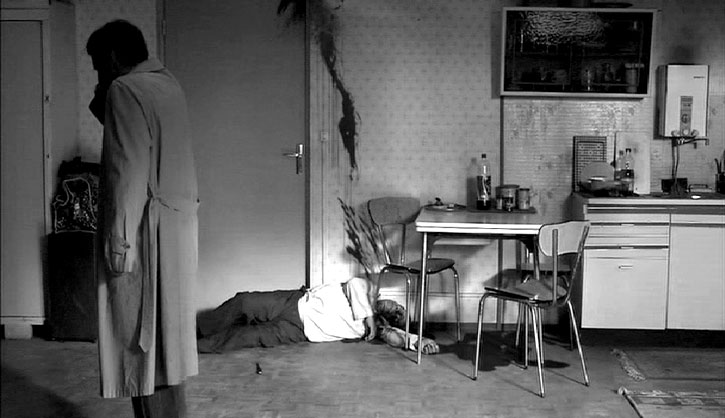
Among many significant scenes, I take Georges’s second visit to Majid’s flat as a kernel of the film’s structure. Its impressiveness, of course, bursts out of Majid’s sudden suicide; Majid lets Georges in, talks for a second, takes out a knife as Georges slightly falters, and slits his own throat, leaving no room for anticipation. The abruptness of this action marks the abruption of Majid’s emotion: a remarkable calmness and gentleness, not usually found in revenge suspects. It is rather Georges, the white Parisian intellectual, who has always lost his temper in front of his lower class, dark-skinned brother (and later, in front of Majid’s son, too); this Algerian outcast has reversed the standard image of the brutal invader of the bourgeois family like the De Niro figure in Cape Fear (Martin Scorsese, 1991). By killing himself, Majid releases something repressed beneath his tranquil face and fractures the peace of both his banlieue home and Georges’s bourgeois life. The flash of his blood sprayed onto the wall visualizes this fracture like an unstitched slash; the blood slowly exuding from his head onto the floor insinuates that this trauma will only grow like a nightmare in Georges’s memory.
In view of other scenes, Majid’s bloodstain on the wall triggers a déjà-vu that allows us to retroactively recognize the drawings sent to Georges (of a child vomiting blood) as forewarnings of this suicide. And through the same logic of ‘deferred action’ (Freudian Nachträglichkeit), this bloody event serves to repeat the film’s first instant flashback, prompted by a reverse-action tape, of young Majid coughing tubercular blood by a window, and the childhood trauma staged in Georges’s nightmare: Majid kills a cockerel, which also leaves a sharp blood mark, and he approaches Georges with the bloody hatchet. This killing was in fact orchestrated by Georges, but he told his parents that Majid had wanted to scare him, a joking lie that, along with Majid’s tuberculosis, ultimately resulted in Majid’s expulsion. However, only through recurrent visual traces after the fact does that original scene manifest its latent meaning as Georges’s original sin. The question would be how guilty and responsible the child and/or adult Georges is for that tiny ‘twisted joke’ that had lifelong repercussions/consequences for Majid. One may conclude: “Georges’s refusal as an adult to acknowledge the effects of his earlier actions suggests a parallel with the postcolonial metropolitan who is neither wholly responsible for, nor wholly untainted by, past events from which he or she has benefited” (Ezra and Sillars 219).1 Or, Majid’s suicide might bring a deep, if guilty, pleasure to a deeply ‘twisted’ xenophobe European: “the comforting idea that the colonial native can be made to disappear in an instant through the auto-combustive agency of their own violence” (Gilroy 234).
Rather than relying on these interpretations, I call attention to the fundamental cinematic mechanism that causes this hermeneutic turmoil around the colonial legacy. The first element that even formalist reviewers miss is the apparently insignificant dialogue. After entering the flat, Georges asks what Majid wants, and hears: “I truly had no idea about the tapes.” Georges asks again: “Is that all?” Then, Majid utters his last words: “I called you because I wanted you to be present.” Georges is required to be a witness, a photographer, a living index to Majid’s death, just as Majid’s blood leaves its physical trace like a gigantic fingerprint. Indexicality marks the ontological essence of this Bazinian sequence shot with two oppositional beings, and furthermore, triggers another deferred action. This time, however, the event does not signal the past but the future, wherein Majid seems to call out from beyond the grave: ‘Look at me dying like the cockerel, and suffer from your presence at my death when this moment haunts you like a ghost’. How could this present moment appear in the future as the return of the past? A hidden camera! Surely, this still long take, framed as a static long shot, hints at a surveillant gaze which seems to offer the true meaning of Majid’s will: ‘I actually wanted you to be present in front of the camera that will send you a tape showing your very presence at my death’. Thus Georges is not the witnessing subject, but the object witnessed by a faceless subject, not an index-maker but an index-image itself.
Nonetheless, we remain unsure of the hidden camera not only because of Majid’s strong denial of its presence, but because of the fact that his supposedly recorded suicide is not actually delivered to Georges until the end of the film. The circumstances of this video’s delivery to Georges are opposite to those surrounding a previous ‘surprise’ video, sent to him directly after his first visit. The previous video, (which recorded Georges’s first visit to Majid and then Majid’s sobbing after Georges’s departure) had the same static, surveillant set-up as the suicide video. But Haneke made it clear to us during that first visit that there was no camera(man) present, since all sides of Majid’s flat could be seen in the background through shot/reverse-shot exchanges. One could imagine a tiny unrecognizable camera, but the opening scene video was shot from the position of someone who must have stood on the street and fixed a conventional camera firmly on a tripod (though this cameraman is also improbably invisible).
Undoubtedly, this impossible gaze is the aesthetic target of many debates surrounding the film. Libby Saxton, for instance, takes a Deleuzian approach to the offscreen space incubating this hidden gaze. What Deleuze defines as the ‘virtual’ out-of-field is “a more disturbing presence, one which cannot even be said to exist, but rather to ‘insist’ or ‘subsist’, a more radical Elsewhere, outside homogeneous space and time” (30).2 In Caché, we experience this radical invisible field through its visible counterpart, the video, while this “interface between offscreen and onscreen space becomes the locus of concerns about personal and collective trauma, guilt and responsibility” (Saxton 6). At this point, however, we should ask what this ‘interface’ really means. By exploring the term more specifically, we can also elaborate on offscreen space and its function. For this task, I will take my cue from the Žižekian usage of interface in his remodeling of suture theory-a remodeling that I wish to in turn reconceptualize. The concept that needs an archeological detour is not offscreen space so much as suture, for suture relates to both offscreen and onscreen space.
Suture as Meta-suture or De-suture
The concept of suture was crucial in the heyday of 1970s theory (Silverman 193-236; Rodowick 180-220). Semiotically, as Žižek says, suture is defined as the process by which “the ‘absent one’ is transferred from the level of enunciation to the level of diegetic fiction” (32). Enunciation designates the process of producing diegesis in which the producer, the enunciator, is not seen, but this absence does not unsettle the spectator because almost every shot appears to be taken from a certain character’s perspective as if he were the very enunciator of the previous or following shot. Georges’s first visit to Majid replays such a classical example of suture: the objective shot of Georges raises the question (‘from whose subjective point of view is this filmic enunciation given?’), which is smoothly and swiftly answered through its reverse-shot showing Majid (the ‘absent enunciator’ turns into a diegetic figure). Suture designates this turning point through which “the difference between image and its absence/void is mapped onto the intra-pictural difference between the two shots” (Žižek 33). In semiotic-psychoanalytic terms, every different shot-not only in the shot and reverse-shot exchange but also in the editing process as a whole-results from the suture of the invisible externality into the chain of visible shots as ‘symbolic’ signifiers; it thereby keeps stable and seamless the diegesis as an ‘imaginary’ world so that spectators, for the most part, hardly recognize this mechanism in the middle of identification with characters and immersion into narrative space. It is ultimately the spectator’s subjectivity that is unconsciously sutured into this unified imaginary reality, the subjectively signifying world woven through objective audiovisual signifiers.
Žižek’s intervention occurred when, after its hegemony had declined, ‘suture’ became vague jargon synonymous with ‘closure’ that yields the totality of a structure. In order to reinvigorate this outmoded buzzword, he brings to light the initial radical difference between the onscreen image and the offscreen void. For the threatening intrusion of the latter, the decentring Other, the Absent Cause, can leave its trace onscreen as if not completely sutured. An apparently objective shot turns out to be a subjective one or vice versa in the suturing process, but as often seen in Hitchcock, we can encounter an inhuman gaze or a monstrous evil that embodies “the impossible/traumatic subjectivity of the Thing itself” (Žižek 38). The burning Bodega Bay with birds gliding over it in The Birds (1963) appears to be shot neither objectively nor subjectively, but semi-subjectively. The invisible Thing can also intrude into a shot, leaving “a blot of the Real” like a bird’s attack on Melanie. If standard suture creates a seamless, illusionist narrative space and illusory reality, Žižek’s late-Lacanian version reveals that the Imaginary-Symbolic conjunction cannot always efface the seam, leaving the trace of the un-symbolized Real which abruptly emerges like a Lacanian stain. Suture thus no longer functions as the undetectable mechanism of signifying representation, but as the unconcealed symptom of its own failure. It is the onscreen appearance of the Real itself, the visualization of the rupture of the suture as such. Conversely, those birds look like a sutured form of the Real, as it were, a ‘slashing’ suture within the ‘slick’ suture.
What Žižek calls “interface” concerns a more specific case, distinct from the material cinematic component described at the outset of the paper. Žižek’s version indicates a screen within the screen serving as “the direct stand-in for the ‘absent one'” mostly appearing in the form of “a simple condensation of shot and reverse-shot within the same shot” (52). A typical example of this is the beginning of Blue (Krzysztof Kieslowski, 1993) when the object of Julie’s look, a doctor, appears as a reflection in her own eye. Such a reflected image then loses its sense of reality, as if to visualize the spectral, fantastic Real. That is, an interface is a ‘meta-suturing’ or, I would say, ‘de-suturing’ image surface within a shot that self-reflexively visualizes the imperfection of classical suture by ‘directly’ suturing the Real. Claiming that “an interface-artificial moment must suture-stitch [the Real],” Žižek in effect re-sutures the notion of suture into film theory in terms of ‘meta-suture’ or ‘de-suture’ that divulges and thereby thwarts the traditional suture itself. Hence, there is what he calls the “short-circuit” that operates on two levels: (1) as a semiotic short-circuit between the Imaginary-Symbolic coalition that produces reality effects and the external Real that is still inaccessible to the subject; (2) as a psychoanalytic short-circuit between objective reality constituted from our subjective viewpoint and the traumatic Real outside this ordinary reality.
Neither subjective nor objective, the interface as suture therefore appears in the convolution of reality and the Real. In view of Lacan’s well-known diagrams on vision (Lacan 105-35), does this short-circuit not take place when two triangles overlap each other as shown in the third diagram below?
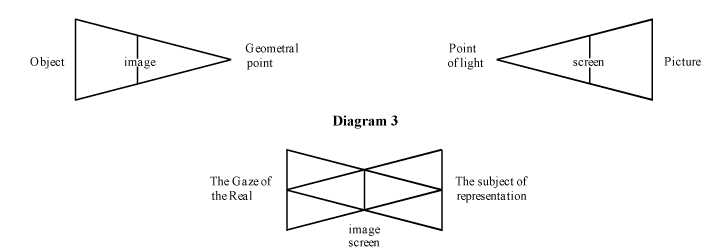
In diagram 1, the “Object” (Thing) is sutured into the “image” by our subjective act of seeing and symbolizing it from the “Geometral point” (eye). In diagram 2, the “Point of light” (the Gaze of the Real) positions us a priori in the “Picture” (our visual field) from which we see, while it is hidden behind the “screen” as a veil of the Gaze. And in diagram 3, the “Gaze of the Real” is sensed in the visual field of the “subject of representation” when the “image” functions as the “screen” of the Real in their short-circuit. Apparently dialectical, this schema, however, has nothing to do with the standard version of the Hegelian flowchart of thesis-antithesis-synthesis. What counts is not continuous reciprocity or equal correspondence between the Gaze and the subject’s eye, but rather their radical disjunction or nondialectic asymmetry. At the moment of suture becoming de-suture, the overlap of the “image” with the “screen” is virtually the replacement of the former with the latter. The eye is already encompassed or preceded by the Gaze which, never directly looked at by us, is only vaguely sensed when directly sutured in an imaged form of the gaze little-g (as derived from but opposed to the Gaze)-in other words, a visible interface.3 The interface appears as this uneven merge of image-screen, making us realize that our subjective eye is ‘asymmetrically’ conditioned by the immanent status of the Gaze which constitutes our visual field. We see and are within this field without seeing the being of its hidden Gaze until an interface hints that we have been seen by that very Gaze.
“I am photographed before I photograph”
To return to the initial question on Caché: why video? It is now clear that the video as an image-screen incarnates such a perceptual and ontological interface in the properly medium-specific sense of the term. When the opening outdoor image (Shot A) suddenly reappears on the TV Georges watches (Shot B), the latter functions not as a reverse-shot, but as an ‘interface-shot’ with the former sutured into it: a condensation of shot and reverse-shot. Sutured in the form of the video-interface, the outside of the house or, say, the external Real invades the inside of Georges’s reality. The crux of the Žižekian suture (which Žižek himself does not highlight) is that it opens this ‘outside’ within the diegesis (and not the extradiegetic space of filmmaking). As the objective Shot A turns out to be a subjective shot, it must have been shot not directly from the viewpoint of the external enunciator (i.e. the ‘seamless’ director), but primarily from the viewpoint of an internal enunciator as a diegetic character who is exterior to all other characters. That is, the video producer can be identified neither as Majid nor his son-who also persistently denies Georges’s suspicion-but only as somebody else in the ‘marginal’ narrative space that no other character enters and in the ‘liminal’ narrative time that lingers in the back of the main character’s memory. While not belonging to the main diegesis, s/he remains ‘intradiegetic’.
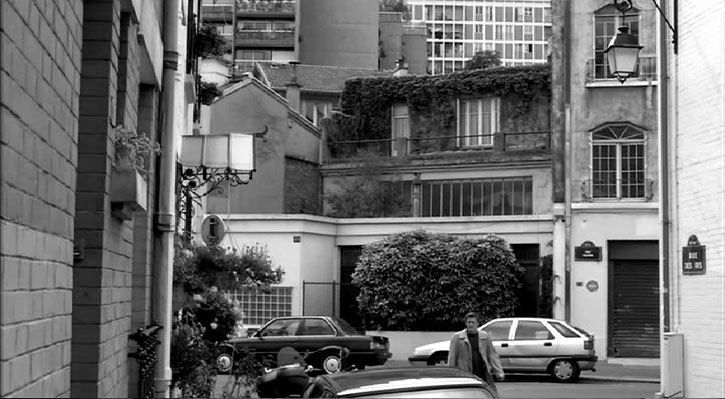
Shot A
More uniquely, this hidden character manifests neither as a pseudo-subject like an animal or ghost, nor as “standard Gothic elements (apparitions in the fog, magic mirrors)” (Žižek 39); instead, it lingers as an image surface of ordinary reality, which persists in complicating the matter of perception and representation. The pure Gaze immanent in Shot A seems sutured into Shot B as a diegetic gaze, yet this in turn only becomes the object of the other character-subject’s look as Georges watches it. The unverified subject persists as nothing but the inhuman Gaze itself. So when we say the objective Shot A turns into a subjective one, this subjectivity should rather be attributed to characters (and spectators) whose view of reality would fit such a normal perspective of the house; the image taken from the ‘geometral point’ of the ‘subject of representation’. On the contrary, the unseen subject who shot this video turns out to be an ‘asubjective’ agent of the Gaze which belongs to the ‘real’ objectivity beyond Georges’s and our field of vision. The intradiegetically external viewpoint only hints that there might be no human character to occupy this position except for a non-anthropomorphized camera-eye as such.
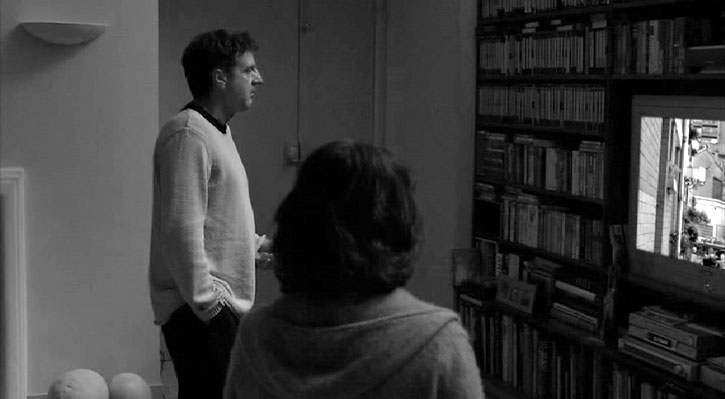
Shot B
While Caché plays a ‘mind-game’ vis-à-vis the question of whether or not we see Georges’s house in Shot A from within someone’s mind, the film provokes a deeper feeling that “I myself [i.e. the film’s narrator through whom I see the film, my stand-in in the film] do not exist” (Žižek 67). Insofar as suture theory concerns spectatorship, suturing as interfacing with the Real does not perfectly suture spectators within the diegetic space, but leaves them wandering around the unsutured Gaze. They are invited to perceive the fictional world through the eyes of an ‘experiencing consciousness’, yet this consciousness is not embodied but disembodied. One may say that it is a moral consciousness or super-ego of sorts, a lingering remnant in the back of Georges’s consciousness that is always watching, always terrorizing with its demands. As Georges’s reality of well-being is constituted only through a certain loss of reality, an exclusion of the traumatic Real, the video interfaces with this loss of the Real while also making him realize that what he sees is constituted only through what he cannot see. The same is true of the spectator, whose gaze is sutured not as belonging to a subject-character with whom to identify, but only as becoming the object of the character’s look: Georges’s diegetic eye that is already both penetrated and surrounded by the invisible Gaze. “Gaze is the condition of possibility of the eye, i.e. of our seeing something in the world (we only see something insofar as an X eludes our eye and ‘returns the Gaze’)” (Žižek 65).4 Lacan says, “I am photo-graphed” (by the Point of light) (121), and I add, ‘before I photograph’ (from my geometral point).

Shot C
The suicide scene ultimately refers to the existence of this Gaze whose empty position spectators assume, while it retroactively proves its unsuturability-the resistance of this Gaze to being sutured into reality. More notable, however, is the fact that suture takes place only through the material interface, the hygienic high-tech surface of a shadowless image; the suicide shot looks like, and functions as, a ‘quasi-interface’ about which we are still uncertain as to whether it is just filmic narration or another would-be inset video. This is the case with the penultimate shot of Georges’s apparent dream (followed by his going to bed)-a fixed extreme long shot of his past presence at Majid’s traumatic expulsion from the family. It is unclear whether or not the camera position of this shot indicates young Georges’s position at the moment, or whose point of view it is that restages this ‘primal scene’, if neither Georges’s nor the director’s himself. We could say the Gaze might be internalized in the unconscious of Georges who sends himself a quasi-interface flashback video. But the question only becomes more unsolvable through a ‘false connection’ to the film’s ending (i.e. without any coherence but some uncanny noise continuing)-Majid’s son, the only suspect who might have been shooting this footage of Georges’s son’s school, surprisingly though almost indiscernibly, enters the frame and talks to Georges’s son in extreme long shot (Shot C). In order to identify and interpret this visual, semantic conundrum,5 it is we the audience who must now replay this quasi-interface shot. It also confronts us with our theatre space which may in fact resemble the stairway, with some people still seated and others exiting at the moment the credits close the film. Doesn’t this interface-screen, then, return the hidden Gaze like a mirror of our physical body if not of our fictional desire?
In brief, Caché gears sociopolitical and psychoanalytical hermeneutics into the ontology and epistemology of the media/image. It carries the ‘whodunit’ semiotics based on the communication/enunciation model to an extreme of perception theory. The interface is given as the only possible threshold through which the Gaze is sutured in front of the human look; the latter senses the unsuturable, unsutured former in its own reflexive/retroactive circuit. This is a distorted feedback of two different perceptions-the Gaze and the eye-which are contingently encountered, asymmetrically exchanged, and unfairly renegotiated. So, too, are two different memories entailing deferred actions-memory of the Real and memory in reality-as Georges’s once sutured memory about Majid is reopened like the bloody gash at the moment Majid’s knife rips through his skin. We only see the (quasi-)interfacial image-screen, but without it we could have no epistemological chance to consider the ontological Gaze that conditions our seeing and being. If Majid embodies a certain agency, it would be less the self-demolition of France’s former colony than the inherent disequilibrium between two sides of the interface, their asymmetrical mutuality. Caché brilliantly discloses how subjectivity is structured in this interfaciality, the inner mechanism of our perceptual and mnemonic lives.
Notes
1. This Screen issue referenced has a dossier on Caché, with most of the authors taking the postcolonial perspective with the reference to the 1961 event-a hidden massacre of hundreds of Algerians which later brought the Algerian war to metropolitan France.
2. Before discussing Deleuze, Saxton introduces a mini-history of the discourse on offscreen space: from André Bazin’s window metaphor and Noël Burch’s ‘actual’ offscreen space to Pascal Bonitzer’s “field of blindness” including the production space (“an ‘anti-classical’ hors-champ which is discontinuous with and heterogeneous to the space on the screen”).
3. To enhance clarity despite possible reductionism, I draw further attention to this distinction, which Žižek does not make, between the Gaze with a capital G and the gaze little g. The former is the pure, invisible Real, the latter its visualized form, an imaged signifier in reality. This distinction would be necessary and effective in locating an onscreen interface-gaze through which we could sense the unlocatable pure Gaze.
4. Libby Saxton reaches this point as well, though not via Lacan-Žižek. “[O]ur blind spots – not only to personal and collective traumas […] but also to the sites of non-seeing which structure cinema and spectatorship […] the margins of blindness, which frame and limit our look, but are also, it suggests, a condition of our seeing” (15).
5. Is Majid’s son threatening Georges’s son, or rather conspiring with him to play a trick on Georges? If the latter is the case, is this the end of the storyline, or rather its beginning that even precedes the opening scene?
Works Cited
Deleuze, Gilles. Cinéma 1: l’image-movement. Paris: Minuit, 1983.
Ezra, Elizabeth, and Jane Sillars. “Hidden in Plain Sight: Bringing Terror Home.” Screen 48.2 (2007): 215-21.
Gilroy, Paul. “Shooting Crabs in a Barrel.” Screen 48:2 (2007): 233-35.
Lacan, Jacques. Le Séminaire XI : les quatre concepts fondamentaux de la psychoanalyse. Paris: Seuil, 1973.
Saxton, Libby. “Secrets and Revelations: Offscreen Space in Michael Haneke’s Caché (2005).” Studies in French Cinema 7.1 (2007): 5-17.
Rodowick, David Norman. The Crisis of Political Modernism. Berkeley: University of California Press, 1994.
Silverman, Kaja. The Subject of Semiotics. New York: Oxford University Press, 1983.
Žižek, Slavoj. The Fright of Real Tears: Krzysztof Kie?lowski Between Theory and Post-Theory. London: BFI, 2001.

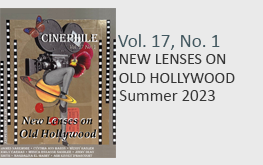
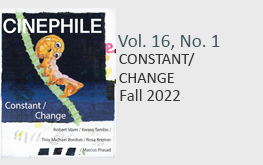
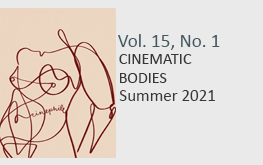
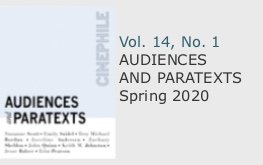
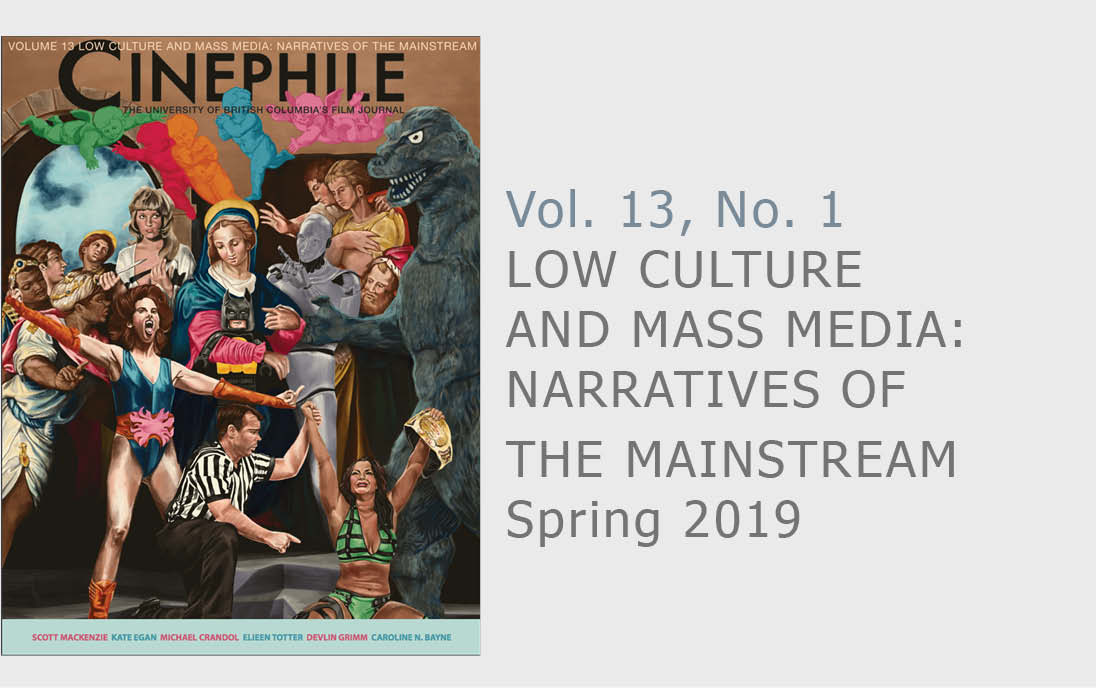
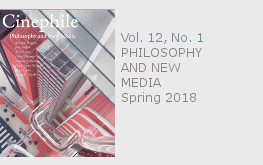
[…] The Haneke MacGuffin: What is the mystery? and a long essay in Cinephile by Seung-hoon Jeong, Gaze, Suture, Interface: The Suicide Scene in Michael Haneke’s Caché. Personally, I haven’t the slightest idea what this Lacanian stuff means, and I don’t […]